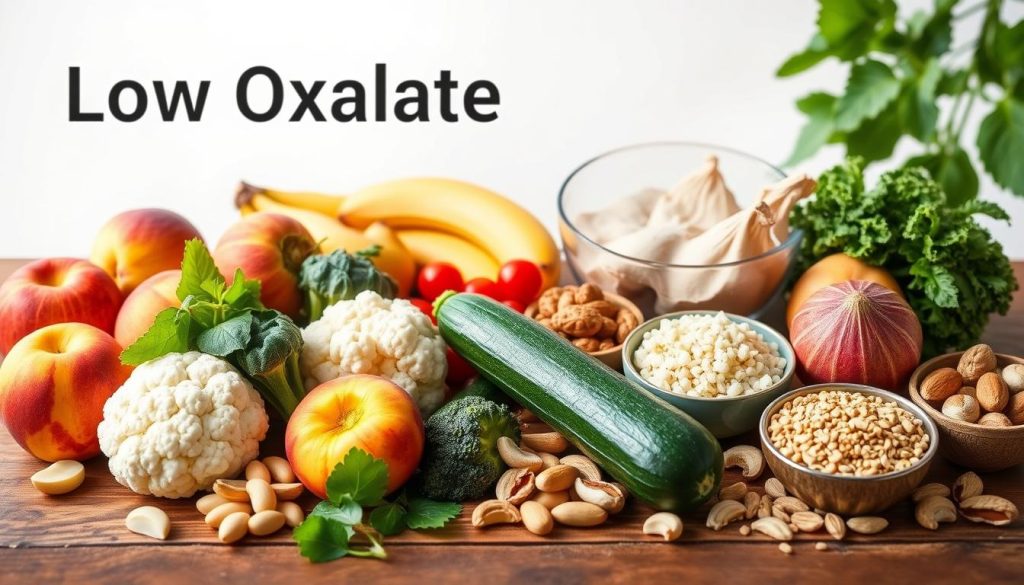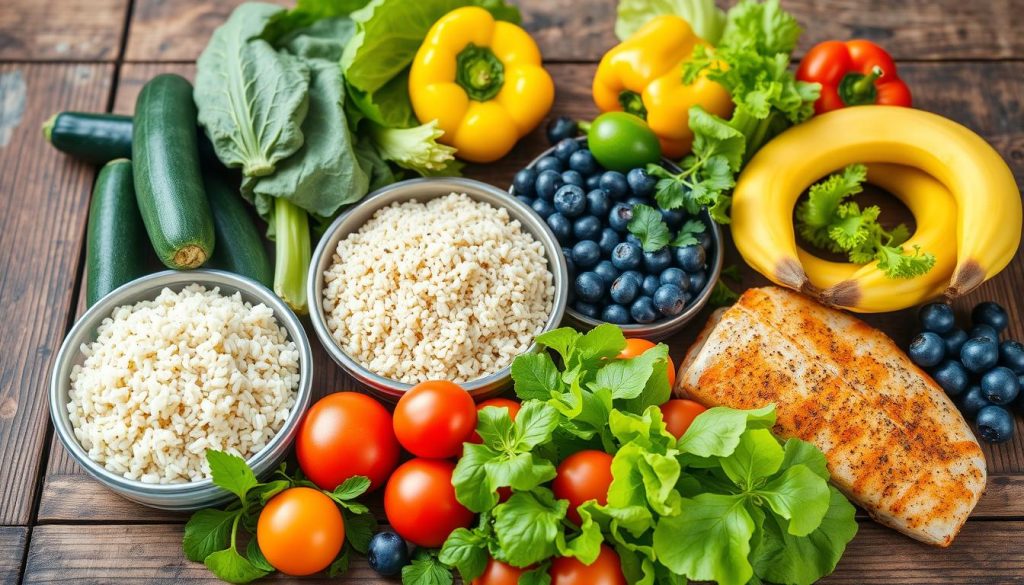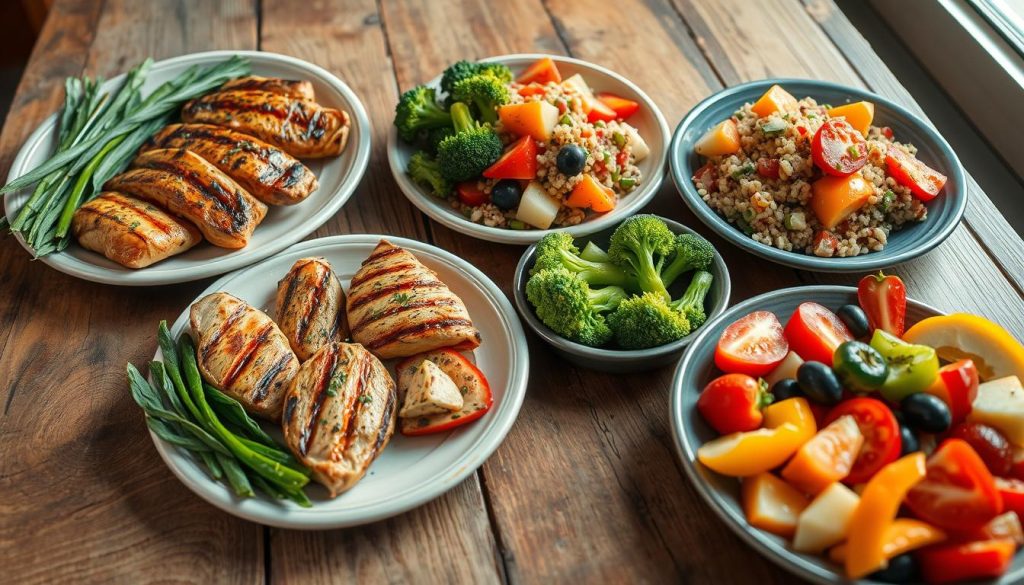Benefits of Low Oxalate Foods: A Guide to Better Health
Eating foods low in oxalates can help your health a lot. This is especially true for people who might get kidney stones. Oxalates are found in many plant foods. They’re not bad by themselves, but too much can lead to kidney stones.
Following a low oxalate diet can really help. It means eating foods with less than 100 mg of oxalates a day. Some doctors even say to eat less than 50 mg. Eating foods low in oxalates can help keep your kidneys healthy. It can also make kidney stones less likely.

Key Takeaways
- A low oxalate diet can help reduce the risk of kidney stone formation.
- Healthcare providers typically recommend limiting oxalate intake to less than 40-50 mg per day.
- Common low oxalate fruits and vegetables include bananas, blackberries, broccoli, and cabbage.
- Consuming calcium-rich foods can help decrease oxalate absorption and prevent kidney stones.
- Maintaining a balanced diet and staying hydrated are also crucial for kidney stone prevention.
Understanding Oxalates: What They Are and Their Impact on Health
Oxalates are found in many plant foods like leafy greens and fruits. They can affect our health, especially kidney stones.
The Science Behind Oxalate Formation
Oxalate comes from our body’s processes and food. It can form crystals with calcium in the kidneys. These crystals can cause kidney stones.
How Oxalates Affect Your Body
Too much oxalate can harm us. It can block nutrient absorption and cause inflammation. People prone to kidney stones should eat less oxalate.
Natural Sources of Oxalates
Oxalate is in many plant foods. Some foods have a lot of it. Here are some examples:
- Spinach
- Rhubarb
- Beets
- Swiss chard
- Nuts, such as almonds and cashews
- Cocoa and chocolate
The amount of oxalate in foods can change. It depends on how the food is grown and prepared.
The Benefits of Low Oxalate Foods
Eating low oxalate foods can help a lot. It’s good for urinary tract wellness, oxalate sensitivity, and anti-inflammatory needs. These foods help prevent kidney stones, which affect over 10% of people.
Low oxalate diets can lower the risk of calcium oxalate stones. These stones make up 80% of all kidney stones. Eating less of these foods helps keep calcium and oxalate in balance. This makes it less likely for stones to form in the urinary tract.
Low oxalate diets also help with other health issues. They can ease symptoms of digestive problems and autoimmune diseases. Oxalates might cause vulvodynia, a pain in the vulva, and problems in cystic fibrosis. They might also help with autism and hypothyroidism by improving gut health and mineral absorption.
| Condition | Potential Benefits of Low Oxalate Diet |
|---|---|
| Kidney Stones | Reduced risk of calcium oxalate stone formation |
| Vulvodynia | Alleviation of chronic vulvar pain |
| Cystic Fibrosis | Potential to prevent complications |
| Autism | Improvement in symptoms by enhancing gut health |
| Hypothyroidism | Better management of thyroid function |
Even though a low oxalate diet might limit some foods, it can still be balanced. With the help of a healthcare professional or dietitian, you can make a meal plan that fits your needs. This way, you can eat well while managing your health.
Adding low oxalate foods to your diet does more than just prevent kidney stones. It can also improve urinary tract wellness, anti-inflammatory effects, and oxalate sensitivity management. By choosing wisely and tailoring your diet, you can boost your health and happiness.
Kidney Stone Prevention and Management
Kidney stones hurt a lot and are very common. They affect millions of people around the world. The most common stones are calcium oxalate stones. Knowing how to prevent them is key to keeping your kidneys healthy.
Types of Kidney Stones
Calcium oxalate stones are the most common. They make up about 80% of all stones. These stones form when calcium and oxalate in the body mix and stick together in the urinary tract.
Risk Factors and Prevention Strategies
Some things can make you more likely to get calcium oxalate stones. These include high oxalate levels in your urine and drinking less water. Also, some health conditions can raise your risk. But, there are ways to stop these stones from forming:
- Drink more water: This helps keep your urine diluted and flushes out bad stuff.
- Eat less sodium and animal protein: Too much of these can make your urine have more calcium and oxalate.
- Get enough calcium: Don’t think you should eat less calcium. Eating 1000-1200 mg a day is good.
- Avoid foods high in oxalates: Foods like nuts, rhubarb, and some berries have a lot of oxalates. Eating less of these can help.
- Manage health conditions: Diseases like Inflammatory Bowel Disease and Hyperparathyroidism can increase your risk. Make sure to manage them well.
By following these tips and eating a balanced diet low in oxalates, you can lower your risk of getting calcium oxalate stones. This helps keep your kidneys healthy.
Preventing and managing kidney stones is all about living healthy. Drink plenty of water and talk to your doctor. They can help you make a plan to stay safe.
Essential Low Oxalate Foods for Your Diet
Creating a diet with low-oxalate foods can greatly improve your health. Foods without oxalates help manage kidney stones and lower health risks.
Fruits like apples, pears, and watermelon are great choices. They offer vitamins and fiber without high oxalates. Broccoli, cauliflower, and lettuce are also good options for veggies.
Grains such as white rice and corn flour are good picks. Eggs, meat, and most dairy products are also safe. Remember, how you cook veggies can change their oxalate levels.
Adding some foods with moderate oxalates (10-25mg per serving) is okay. This way, you can have a tasty and healthy diet. It supports your health and wellbeing.

“Incorporating low oxalate foods into your diet is a simple yet powerful step towards better health and reduced risk of kidney stones.”
The Role of Calcium in Oxalate Management
Calcium is key in managing oxalate levels and preventing kidney stones. When you eat calcium with oxalate-rich foods, it binds to oxalate. This reduces how much oxalate your body absorbs. This is called the calcium-oxalate interaction.
This interaction helps keep oxalate absorption and dietary calcium levels healthy.
Calcium-Oxalate Binding Process
The calcium-oxalate interaction happens in the intestines. Calcium and oxalate form a complex that is then passed out of the body. This stops oxalate from getting into the blood.
Less oxalate in the blood means less chance of kidney stones.
Optimal Calcium Intake Guidelines
- The recommended daily calcium intake is 1,000-1,200 mg for most adults.
- Good sources of dietary calcium include dairy products, leafy green vegetables, fortified foods, and certain nuts and seeds.
- Balancing calcium and oxalate intake is more effective than strictly limiting oxalate intake alone in preventing kidney stones.
Knowing about the calcium-oxalate interaction helps manage oxalate absorption. It also helps keep dietary calcium levels right. This way, you can lower your risk of kidney stones.
Creating a Balanced Low Oxalate Meal Plan
Making a balanced low oxalate meal plan is key for your health. It helps prevent kidney stones. You need to eat a mix of low and moderate oxalate foods. This ensures you get all the nutrients your body needs.
Focus on lean proteins, low-oxalate fruits and veggies, and foods rich in calcium. This way, you can make tasty meals that are good for you.
A typical day on a low oxalate diet might include:
- Breakfast: Oatmeal with berries
- Lunch: Turkey sandwich on white bread
- Dinner: Grilled chicken with steamed broccoli and white rice
Drinking lots of water is also important. It helps remove oxalates and keeps your kidneys healthy.
| Nutrient | Importance in a Low Oxalate Diet |
|---|---|
| Protein | Lean proteins, such as chicken, turkey, and fish, provide essential amino acids without contributing significant amounts of oxalates. |
| Calcium | Calcium-rich foods, like dairy products, can help bind to oxalates and reduce their absorption, making them a key component of a low oxalate diet. |
| Fiber | High-fiber, low-oxalate foods, such as oats, barley, and certain fruits and vegetables, can promote digestive health and support overall wellness. |
By planning balanced, low oxalate meals and staying hydrated, you can enjoy delicious and nutritious foods. This is a big step towards better kidney health and less risk of kidney stones.

Foods to Avoid on a Low Oxalate Diet
For people who get kidney stones or have health issues from high oxalates, a low oxalate diet is key. There are many healthy foods to eat. But, it’s important to know which high oxalate foods to limit or avoid.
High Oxalate Foods List
Here are some foods high in oxalates to limit or avoid:
- Spinach
- Rhubarb
- Nuts, such as almonds, pecans, and peanuts
- Chocolate
- Beets
- Sweet potatoes
- Wheat bran
- Buckwheat
- Soy products
These foods have a lot of oxalates. Oxalates can lead to kidney stones and other health problems. It’s important to watch how much of these foods you eat.
Common Food Substitutions
To keep your diet balanced and healthy, try these substitutions:
- Use cauliflower instead of potatoes
- Choose low-oxalate nuts like macadamia or pistachios
- Opt for green tea instead of black tea
- Experiment with low-oxalate vegetables like green beans, broccoli, and carrots
- Incorporate more calcium-rich dairy products, such as cheese and yogurt
Changing your diet slowly and with help from a healthcare provider or dietitian is best. This way, you can meet your nutritional needs while on a low oxalate diet.
Implementing Dietary Changes Successfully
Changing to a low oxalate diet is a big step. But, it can be done with the right steps. Start by making small dietary modifications and lifestyle changes for better health.
First, find out which foods have a lot of oxalates. Then, pick foods with less oxalates to eat instead. Keeping a food diary helps track what you eat. It shows if certain foods make you feel bad.
Working with a registered dietitian is also key. They make sure your diet is full of nutrients. Don’t forget to drink lots of water, at least 2-3 liters a day.
Check in with your doctor often. They can see how you’re doing and help change your diet if needed. This way, you can celebrate your wins and solve any problems.
Changing to a low oxalate diet takes time and effort. But, with the right help and mindset, you can do it. You’ll feel better and live healthier.
Health Benefits Beyond Kidney Stone Prevention
A low oxalate diet helps prevent kidney stones. It might also help with joint pain and digestion. But, we need more studies to be sure.
This diet is not for everyone. It’s best to follow it with a doctor’s help. Eating whole foods is good for health, even without kidney stone worries.
Eating foods low in oxalate can help in many ways. The Mediterranean diet, similar to this, lowers heart disease and diabetes risk. These are good for your kidneys too.
FAQ
What are the benefits of following a low oxalate diet?
A low oxalate diet can help prevent kidney stones. It’s good for those who have had calcium oxalate stones before. It might also help with oxalate sensitivity or digestive problems.
What is the recommended daily intake of oxalates?
A low oxalate diet means eating less than 100mg of oxalates a day. Some doctors say even less, like 50mg or less.
How do oxalates contribute to kidney stone development?
Oxalate is made by our bodies and found in many foods. It can mix with calcium in the urinary tract. This can lead to calcium oxalate stones. High oxalate levels in urine, especially with low urine volume, raise the risk of stones.
What are the common high-oxalate foods to avoid?
Stay away from foods high in oxalates like spinach, rhubarb, nuts, and chocolate.
What are some examples of low oxalate foods?
Low oxalate foods include apples, pears, and watermelon. Also, broccoli, cauliflower, and lettuce. Grains like white rice and corn flour are good too. Eggs, meat, and most dairy products are safe choices.
How does calcium affect oxalate absorption?
Calcium is key in managing oxalates. It binds with oxalate in the gut, reducing how much is absorbed. Eating calcium-rich foods with oxalate-rich foods can lower oxalate levels in urine.
How can I successfully implement a low oxalate diet?
To follow a low oxalate diet, make small changes and learn about it. Start by finding and replacing high oxalate foods with low ones. Use a food diary, get help from a dietitian, and drink plenty of water.
Are there any additional health benefits beyond kidney stone prevention?
While mainly for preventing kidney stones, a low oxalate diet might also help with joint pain and digestive issues. But, we need more studies to be sure.
Source Links
- Low Oxalate Diet: Overview, Food Lists, and How It Works – https://www.healthline.com/nutrition/low-oxalate-diet
- WHY EAT A LOW OXALATE DIET? – https://kidneystones.uchicago.edu/2017/02/05/low-oxalate-diet/
- Will a Low Oxalate Diet Prevent Kidney Stones? – https://www.verywellfit.com/the-low-oxalate-diet-pros-cons-and-what-you-can-eat-5199579
- Oxalate (Oxalic Acid) – https://www.healthline.com/nutrition/oxalate-good-or-bad
- Oxalic acid (oxalate): What it is, risks, how to avoid it, and more – https://www.medicalnewstoday.com/articles/oxalic-acid
- Oxalate in Foods: Extraction Conditions, Analytical Methods, Occurrence, and Health Implications – https://pmc.ncbi.nlm.nih.gov/articles/PMC10486698/
- Low Oxalate Diet – Jellison Integrative MD – https://jjimd.com/low-oxalate-diet/
- Low Oxalate Diet: Overview, Food Lists, and How It Works – https://www.medicinenet.com/low_oxalate_diet_overview_and_how_it_works/article.htm
- Kidney Stones | Diet Plan and Prevention – https://www.kidney.org/kidney-topics/kidney-stone-diet-plan-and-prevention
- Calcium Oxalate Stones – https://www.kidney.org/kidney-topics/calcium-oxalate-stones
- Low Oxalate Diet – https://arizonadigestivehealth.com/gastroenterology-diets/low-oxalate-diet
- Lowering urinary oxalate excretion to decrease calcium oxalate stone disease – https://pmc.ncbi.nlm.nih.gov/articles/PMC5114711/
- Is It Time to Retire the Low-Oxalate Diet? No! – https://pmc.ncbi.nlm.nih.gov/articles/PMC8575151/
- Foods High in Oxalates – https://www.webmd.com/diet/foods-high-in-oxalates
- Low-Oxalate | Nourishing Meals® – https://nourishingmeals.com/diet/low-oxalate
- How To Eat A Low Oxalate Diet – https://kidneystones.uchicago.edu/2015/11/16/how-to-eat-a-low-oxalate-diet/
- Low-Oxalate Diet: Here’s Is What You Should Eat And Avoid To Prevent Kidney Stones – https://www.netmeds.com/health-library/post/low-oxalate-diet-heres-is-what-you-should-eat-and-avoid-to-prevent-kidney-stones?srsltid=AfmBOorlBykiFCUVkplNU2EOwNbUVO691htrOC4BC2K4Jn3yTf-rnVlP
- Microsoft Word – KidneyStoneOxalateDiet.doc – https://www.mcw.edu/-/media/MCW/Departments/Medicine/Nephrology/Kidney-Stone-Oxalate-Diet.pdf
- Low Oxalate Diet – The Basics – https://richmondnaturalmed.com/low-oxalate-diet/
- What Is a Low Oxalate Diet? – https://www.healthline.com/health/what-is-a-low-oxalate-diet
- Mediterranean Diet Reduces Kidney Stone Formation and Recurrence – https://dreminozbek.com/en/mediterranean-diet-reduces-kidney-stone-formation-and-recurrence/
- Diet to Prevent Kidney Stones by Dr Sanjay K Binwal – https://www.urocare.health/blogs/diet-to-prevent-kidney-stones/






